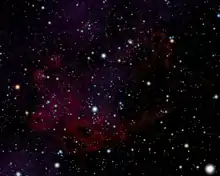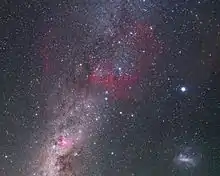Gum Nebula
The Gum Nebula (Gum 12) is an emission nebula that extends across 36° in the southern constellations Vela and Puppis. It lies approximately 450 parsecs from the Earth.[1] Hard to distinguish, it was widely believed to be the greatly expanded (and still expanding) remains of a supernova that took place about a million years ago. More recent research suggests it may be an evolved H II region. It contains the 11,000-year-old Vela Supernova Remnant, along with the Vela Pulsar.
| Supernova remnant | |
|---|---|
 | |
| Observation data: J2000.0 epoch | |
| Right ascension | 08h 00m
|
| Declination | −43° 00′ :″ |
| Distance | 1470 ly (450 pc) |
| Apparent magnitude (V) | +12 (infrared only) |
| Constellation | Vela |
| Physical characteristics | |
| Absolute magnitude (V) | 3.73 (infrared) |
| Designations | Gum 12 |

The Gum Nebula contains about 32 cometary globules.[2] These dense cloud cores are subject to such strong radiation from O-type stars γ2 Vel and ζ Pup and formerly the progenitor of the Vela Supernova Remnant that the cloud cores evaporate away from the hot stars into comet-like shapes. Like ordinary Bok globules, cometary globules are believed to be associated with star formation.[3]
It is named after its discoverer, the Australian astronomer Colin Stanley Gum (1924–1960). Gum had published his findings in 1955 in a work called A study of diffuse southern H-alpha nebulae (see Gum catalog).
Popular culture
The Gum Nebula is explored by the crew of the Starship Titan in the Star Trek novel Orion's Hounds.[4]
See also
References
- Graham, J.A., 1986. Objects associated with low-mass star formation in the Gum nebula. The Astrophysical Journal, 302, pp.352-362.
- Zealey, W. J., Z. Ninkov, E. Rice, M. Hartley, & S. B. Tritton. 1983, ApL, 23, 119.
- Reipurth, B. 1983, A&A, 117, 183. Star formation in BOK globules and low-mass clouds. "I - The cometary globules in the GUM Nebula."
- Bennett, Christopher (2005-12-27). Orion's Hounds. Pocket Books. ISBN 141650950X.
External links
| Wikimedia Commons has media related to Gum 12. |
- Gum Nebula on WikiSky: DSS2, SDSS, GALEX, IRAS, Hydrogen α, X-Ray, Astrophoto, Sky Map, Articles and images
- APOD: Gum Nebula, with mouse over (2009.08.22)
- Galaxy Map: Entry for Gum 12 in the Gum Catalog
- Galaxy Map: Detail chart for the Gould Belt (showing the location of Gum 12 relative to the sun)
- Encyclopedia of Science: Entry for the Gum Nebula (erroneously called Gum 56)
- SouthernSkyPhoto.com